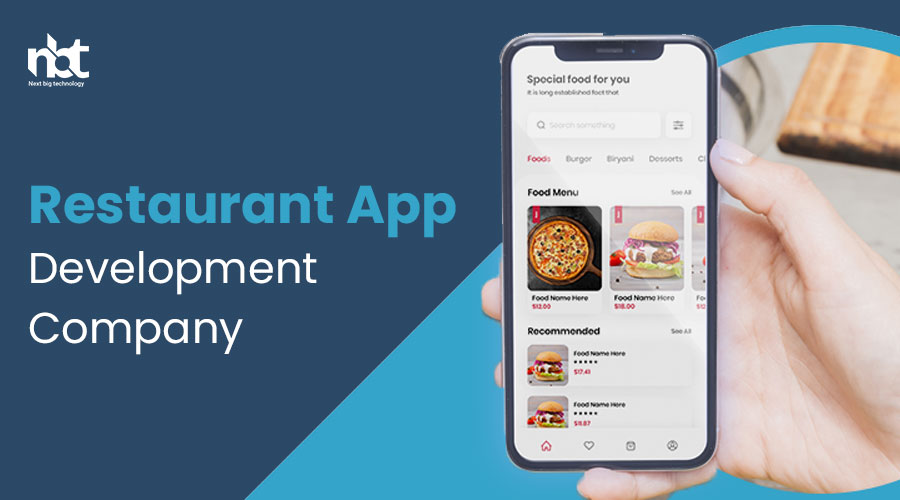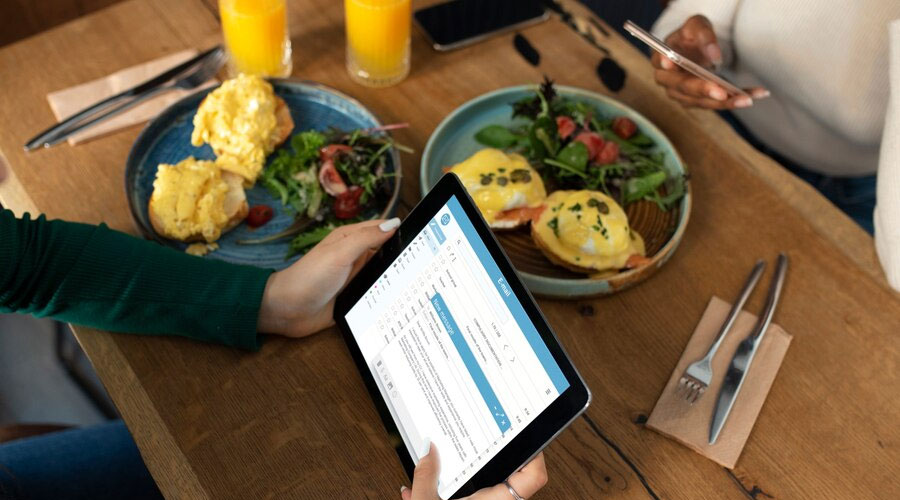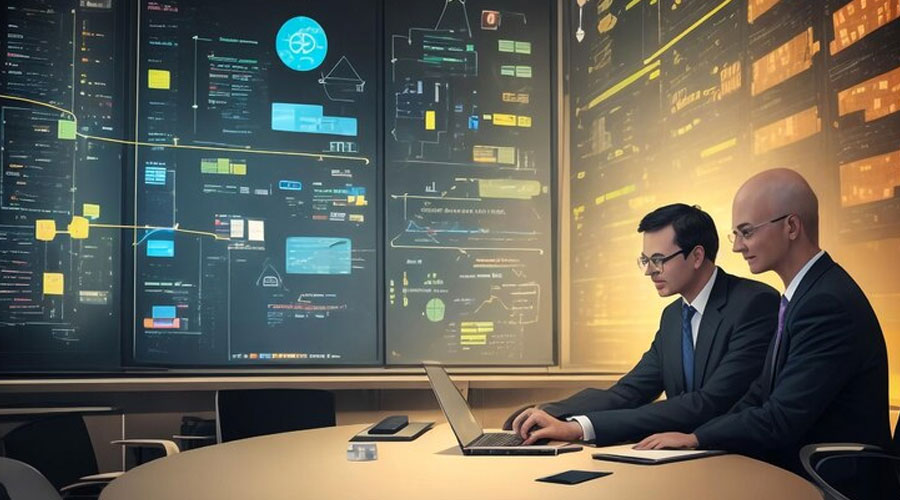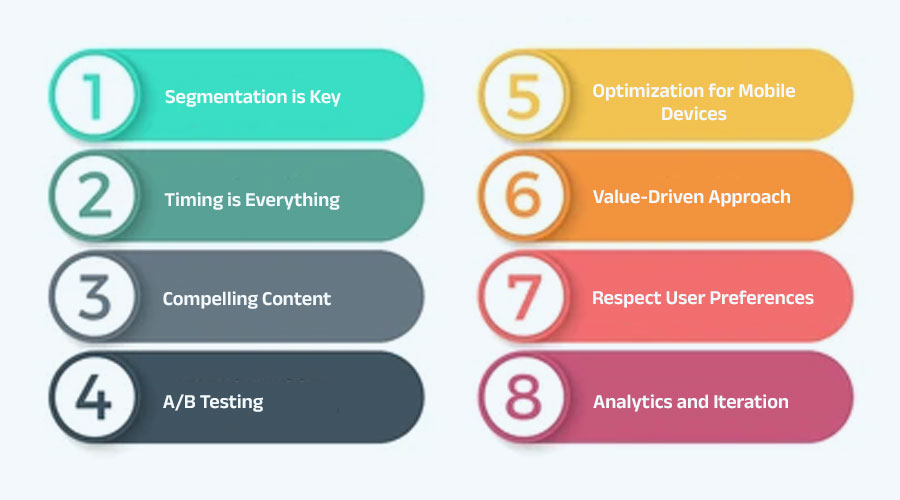Table of Contents
Introduction to Restaurant App Development Company
In today’s digital age, the restaurant industry is experiencing a profound transformation, thanks to the burgeoning popularity of restaurant app development companies. These innovative companies are revolutionizing the way restaurants engage with their customers, streamline operations, and enhance overall efficiency. If you’re a restaurant owner looking to stay ahead of the curve and amplify your business’s success, understanding the fundamentals of restaurant app development companies is essential.
Understanding Restaurant App Development Companies
Restaurant app development companies specialize in creating tailored mobile applications specifically designed to meet the unique needs of restaurants and food service businesses. These apps serve as powerful tools that enable restaurants to offer seamless digital experiences to their customers, improve operational workflows, and drive customer engagement and loyalty.
Key Features of Restaurant Apps
Restaurant apps typically come equipped with a wide range of features and functionalities aimed at enhancing both the customer experience and restaurant operations. Some common features include:
- Online Ordering: Enable customers to browse menus, place orders, and make payments directly through the app, providing them with a convenient and hassle-free ordering experience.
- Table Reservation: Allow customers to reserve tables in advance, helping restaurants manage their seating capacity more effectively and reduce wait times.
- Menu Customization: Offer customizable menus that cater to dietary preferences, allergies, and special requests, ensuring a personalized dining experience for every customer.
- Push Notifications: Send timely notifications to customers about special offers, discounts, new menu items, or upcoming events, helping to drive sales and customer engagement.
- Integration with POS Systems: Seamlessly integrate with restaurant POS (Point of Sale) systems to streamline order management, inventory tracking, and sales reporting.
- Customer Feedback: Collect feedback and reviews from customers directly through the app, allowing restaurants to gather valuable insights and improve their services continually.
Benefits of Restaurant App Development Companies
Partnering with a reputable restaurant app development company can offer numerous benefits for restaurant owners, including:
- Enhanced Customer Engagement: By providing customers with a user-friendly mobile app, restaurants can foster deeper connections and interactions, leading to increased loyalty and repeat business.
- Increased Operational Efficiency: Restaurant apps automate various tasks, such as order processing and table management, reducing manual errors and improving overall operational efficiency.
- Data-driven Insights: Restaurant apps generate valuable data insights, such as customer preferences, order history, and sales trends, enabling restaurants to make informed decisions and optimize their strategies.
- Competitive Advantage: In today’s competitive market, having a well-designed restaurant app can set your business apart from competitors and attract tech-savvy customers who value convenience and innovation.
- Revenue Growth: By leveraging features like online ordering and table reservations, restaurants can expand their customer base and generate additional revenue streams, ultimately driving business growth.
Understanding the Restaurant Industry
In the bustling world of gastronomy, the restaurant industry stands as a vibrant cornerstone, weaving together flavors, cultures, and experiences to satiate our appetite for culinary delights. From cozy cafes to Michelin-starred establishments, this multifaceted realm offers a kaleidoscope of tastes and sensations, each venue bearing its own unique story and ambiance. Let’s delve into the intricate tapestry of the restaurant industry, exploring its nuances and dynamics.
Culinary Landscape: At its essence, the restaurant industry mirrors the diverse culinary landscape of our world. It encompasses a myriad of cuisines, ranging from traditional comfort foods to avant-garde gastronomic creations. Whether it’s a family-run diner serving up homely classics or a fusion bistro pushing the boundaries of culinary innovation, every eatery contributes to the rich mosaic of flavors that define our global palate.
Entrepreneurial Spirit: Behind every bustling kitchen and bustling dining room lies the entrepreneurial spirit that drives the restaurant industry forward. From aspiring chefs with a passion for experimentation to seasoned restaurateurs with a knack for business, individuals from all walks of life converge to transform culinary dreams into tangible dining experiences. It’s this fusion of creativity and commerce that fuels the industry’s growth and innovation, spawning new trends and concepts with each passing season.
Customer Experience: Central to the success of any restaurant is the customer experience—an intangible yet paramount aspect that can make or break an establishment. Beyond the mere act of dining, patrons seek a holistic experience that transcends the plate. From impeccable service and atmospheric ambiance to Instagram-worthy presentations, every element plays a pivotal role in shaping diners’ perceptions and fostering loyalty.
Challenges and Opportunities: Despite its allure, the restaurant industry is not without its challenges. From fluctuating economic landscapes to evolving consumer preferences, restaurateurs must navigate a myriad of obstacles to thrive in this competitive arena. Rising operating costs, labor shortages, and changing dietary trends further compound the complexities faced by industry professionals.
However, amidst these challenges lie abundant opportunities for innovation and adaptation. From embracing technology to streamline operations and enhance guest experiences to championing sustainability practices that resonate with conscientious consumers, forward-thinking restaurateurs are rewriting the playbook for success in the 21st century.
Community and Culture: Beyond its commercial facets, the restaurant industry serves as a vital nexus for community and culture. From neighborhood bistros that serve as local gathering spots to fine dining establishments that celebrate culinary heritage, restaurants foster a sense of belonging and camaraderie that transcends mere sustenance. They serve as platforms for cultural exchange, where diverse cuisines and traditions converge to celebrate the universal language of food.
Importance of Mobile Apps for Restaurants
In today’s fast-paced digital age, the restaurant industry is continually evolving to meet the ever-changing needs and expectations of consumers. One of the most significant developments in recent years has been the widespread adoption of mobile apps by restaurants of all sizes. These apps have revolutionized the way patrons interact with their favorite dining establishments, offering a host of benefits for both customers and restaurant owners alike.
Enhancing Convenience and Accessibility: Mobile apps provide customers with unparalleled convenience and accessibility when it comes to dining out. With just a few taps on their smartphones, diners can browse restaurant menus, place orders, and make reservations from anywhere, at any time. This level of convenience not only saves customers valuable time but also enhances their overall dining experience by eliminating the need to wait in long lines or navigate complex phone systems.
Personalized Recommendations and Offers: By leveraging data analytics and customer preferences, mobile apps allow restaurants to offer personalized recommendations and exclusive offers to their patrons. Through features such as order history tracking and personalized notifications, restaurants can tailor their offerings to individual tastes and preferences, fostering a deeper connection with their customer base. This level of personalization not only enhances customer satisfaction but also encourages repeat business and customer loyalty.
Streamlining Operations and Increasing Efficiency: Mobile apps aren’t just beneficial for customers—they also play a crucial role in streamlining restaurant operations and increasing efficiency. Features such as online ordering and table reservation systems help restaurants manage customer flow more effectively, reducing wait times and maximizing seating capacity. Additionally, mobile apps can integrate with backend systems such as inventory management and point-of-sale systems, automating repetitive tasks and freeing up staff to focus on delivering exceptional service.
Building Brand Loyalty and Engagement: In today’s competitive restaurant landscape, building brand loyalty is more important than ever. Mobile apps provide restaurants with a powerful tool for engaging with their customers on a deeper level and fostering long-term relationships. Through features such as loyalty programs, customer feedback mechanisms, and social media integration, restaurants can keep their patrons informed, entertained, and engaged long after they’ve left the dining table. By consistently delivering value through their mobile apps, restaurants can turn casual diners into loyal brand advocates.
Adapting to Changing Consumer Preferences: Perhaps most importantly, mobile apps enable restaurants to adapt to changing consumer preferences and stay ahead of the curve. As technology continues to evolve and consumer behavior shifts, restaurants must embrace innovation to remain competitive. Mobile apps provide restaurants with the flexibility to experiment with new concepts, gather real-time feedback, and iterate rapidly based on customer insights. Whether it’s offering contactless ordering and payment options or implementing virtual dining experiences, mobile apps empower restaurants to meet the evolving needs of today’s diners head-on.
Key Features of Restaurant Apps
In today’s fast-paced digital era, the restaurant industry is witnessing a significant transformation, thanks to the advent of restaurant apps. These apps have revolutionized the way we dine out or order food, offering convenience, efficiency, and an enhanced dining experience. Let’s delve into the key features that make restaurant apps a must-have for both food enthusiasts and business owners alike.
1. Intuitive User Interface: A user-friendly interface is paramount for any restaurant app’s success. From effortless navigation to visually appealing design, users should find it easy to explore menus, place orders, and make reservations. Clear categorization of dishes, vibrant images, and seamless transitions enhance the overall user experience.
2. Online Ordering and Delivery: The ability to order food online has become a game-changer in the restaurant industry. Restaurant apps streamline the ordering process, allowing customers to browse menus, customize orders, and make secure payments with just a few taps on their smartphones. Integration with delivery services ensures swift and hassle-free food delivery, making it convenient for users to enjoy their favorite meals from the comfort of their homes.
3. Reservation Management: For dine-in experiences, reservation management features are indispensable. Restaurant apps enable customers to book tables in advance, specifying their preferred date, time, and party size. Automated reminders and notifications keep both customers and restaurant staff informed, minimizing no-shows and optimizing table turnover.
4. Loyalty Programs and Rewards: To foster customer loyalty and incentivize repeat business, many restaurant apps incorporate loyalty programs and rewards systems. Customers earn points or rewards for every purchase they make through the app, which can be redeemed for discounts, free meals, or exclusive offers. These programs not only encourage customer retention but also drive engagement and increase sales.
5. Menu Customization and Dietary Preferences: Personalization is key in today’s consumer-centric landscape. Restaurant apps allow users to customize their orders according to their dietary preferences, allergies, or restrictions. Whether it’s opting for gluten-free options, choosing spice levels, or substituting ingredients, customers appreciate the flexibility to tailor their meals to suit their individual tastes and requirements.
6. Real-time Updates and Notifications: Timely communication is essential for keeping customers informed and engaged. Restaurant apps leverage push notifications to update users about order status, delivery tracking, special promotions, or new menu additions. By providing real-time updates, restaurants can enhance transparency, build trust, and foster a sense of anticipation among their patrons.
7. Feedback and Reviews: Feedback channels within restaurant apps empower customers to share their dining experiences, providing valuable insights for both restaurant owners and prospective diners. Users can rate their meals, leave reviews, and offer suggestions for improvement, fostering a culture of continuous feedback and service enhancement. Responsive management can address concerns promptly, demonstrate commitment to quality, and cultivate a loyal customer base.
8. Integration with Social Media: In the age of social networking, integration with popular social media platforms amplifies a restaurant’s online presence and fosters community engagement. Restaurant apps allow users to share their dining experiences, photos of mouth-watering dishes, and reviews on social media channels seamlessly. This user-generated content serves as free advertising, driving brand visibility and attracting new customers through word-of-mouth referrals.
User Interface Design for Restaurant Apps
In today’s digital age, where convenience is key, restaurant apps have become indispensable tools for both customers and restaurant owners. A well-designed user interface (UI) can make or break the user experience, impacting customer satisfaction, retention, and ultimately, the success of the restaurant. Let’s delve into the essential elements of user interface design tailored specifically for restaurant apps.
1. Visual Appeal: The first bite is with the eye, they say, and the same goes for restaurant apps. A visually appealing UI entices users to explore further. Incorporating high-quality images of mouth-watering dishes, elegant restaurant interiors, and enticing food presentations can instantly captivate users and stimulate their appetite.
2. Intuitive Navigation: Just like a well-organized menu in a restaurant, intuitive navigation is crucial for guiding users seamlessly through the app. A clear hierarchy of categories such as menus, reservations, specials, and locations ensures that users can easily find what they’re looking for without unnecessary confusion or frustration.
3. Streamlined Ordering Process: One of the primary purposes of a restaurant app is to facilitate orders. A streamlined ordering process is essential for ensuring convenience and efficiency. Implementing a simple and intuitive order flow with options for customization, special requests, and easy payment methods can significantly enhance the user experience and encourage repeat orders.
4. Personalization Features: Every diner has unique preferences and dietary requirements. Incorporating personalization features such as favorite orders, dietary preferences, and order history can enhance user engagement and loyalty. By providing tailored recommendations based on past orders or user preferences, restaurants can create a more personalized and enjoyable dining experience.
5. Responsive Design: With the increasing use of smartphones and tablets, it’s essential to ensure that the restaurant app is optimized for various devices and screen sizes. A responsive design adapts seamlessly to different devices, providing a consistent user experience across all platforms. This ensures that users can access the app anytime, anywhere, enhancing convenience and accessibility.
6. Real-time Updates: In the fast-paced restaurant industry, menu items, specials, and operating hours may change frequently. Providing real-time updates ensures that users have access to the latest information, preventing any confusion or disappointment. Push notifications can be utilized to alert users about new menu items, special promotions, or upcoming events, keeping them engaged and informed.
7. Integration with Other Platforms: To maximize reach and convenience, restaurant apps should seamlessly integrate with other platforms such as social media, online review sites, and delivery services. Integration with social media allows users to share their dining experiences and recommendations with friends, while integration with delivery services enables users to order food for delivery directly from the app.
Backend Development and Database Management
In the ever-evolving landscape of technology, backend development and database management stand as the pillars upon which robust and efficient digital systems are built. From powering web applications to managing large-scale data, the synergy between backend development and database management is crucial for the seamless functioning of modern software solutions.
Understanding Backend Development:
Backend development refers to the server-side of web development, where the logic, databases, and server architecture work together to ensure the smooth functioning of an application. It encompasses a wide array of technologies and frameworks, each serving its unique purpose in building scalable and secure applications.
- Programming Languages: Backend developers primarily work with languages like Python, JavaScript (Node.js), Ruby, Java, and PHP. These languages offer various frameworks such as Django, Express.js, Ruby on Rails, Spring Boot, and Laravel, simplifying backend development tasks and accelerating the development process.
- Server Technologies: Backend developers utilize server technologies like Apache, Nginx, and Microsoft’s Internet Information Services (IIS) to handle client requests, route traffic, and manage application resources efficiently.
- API Development: Application Programming Interfaces (APIs) serve as the bridge between the frontend and backend, allowing seamless communication and data exchange. RESTful APIs, GraphQL, and SOAP are some of the commonly used protocols for developing APIs.
- Security Measures: Security is paramount in backend development. Developers implement measures such as authentication, authorization, data encryption, and input validation to safeguard against common vulnerabilities like SQL injection, cross-site scripting (XSS), and CSRF attacks.
Database Management:
Database management involves the organization, storage, and retrieval of data in a structured manner to facilitate data-driven decision-making and ensure data integrity and security.
- Relational Databases: Relational Database Management Systems (RDBMS) like MySQL, PostgreSQL, Oracle, and Microsoft SQL Server are widely used for structured data storage. They offer ACID (Atomicity, Consistency, Isolation, Durability) compliance and support complex queries and transactions.
- NoSQL Databases: NoSQL databases like MongoDB, Cassandra, Redis, and Couchbase are preferred for handling unstructured or semi-structured data and for applications requiring high scalability and performance. They offer flexibility, horizontal scalability, and schema-less data modeling.
- Data Modeling: Effective data modeling is essential for designing database schemas that reflect the real-world entities and relationships accurately. Techniques like Entity-Relationship Diagrams (ERD) and normalization help in organizing data efficiently and minimizing redundancy.
- Database Optimization: Database administrators and developers optimize database performance through techniques like indexing, query optimization, caching, and sharding to ensure fast response times and efficient resource utilization.
Best Practices for Backend Development and Database Management:
- Modularity and Scalability: Design backend systems with modularity in mind, allowing for easy scalability and maintenance as the application grows.
- Data Security: Implement robust security measures at both the application and database levels to protect sensitive data from unauthorized access and cyber threats.
- Performance Monitoring: Continuously monitor backend performance metrics like response time, throughput, and resource utilization to identify bottlenecks and optimize system performance.
- Backup and Recovery: Regularly backup database data and implement disaster recovery plans to minimize data loss and ensure business continuity in case of system failures.
- Documentation and Testing: Maintain comprehensive documentation and conduct thorough testing of backend code and database configurations to ensure reliability, maintainability, and compliance with business requirements.
Integrating Online Ordering and Payment Systems
In the digital age, where convenience reigns supreme, businesses are increasingly turning to online platforms to streamline their operations and cater to the evolving needs of their customers. One such area that has witnessed a significant transformation is the integration of online ordering and payment systems. In this guide, we’ll delve into the importance of integrating these systems, the benefits it offers to businesses, and how to do it effectively.
Why Integrate Online Ordering and Payment Systems?
The integration of online ordering and payment systems offers a myriad of benefits for businesses across various industries. Firstly, it enhances customer convenience by providing a seamless and hassle-free ordering process. With just a few clicks, customers can browse through a menu or product catalog, place their orders, and make payments, all from the comfort of their homes or on the go.
Moreover, integrating these systems eliminates the need for manual order processing, reducing the likelihood of errors and streamlining operations. It also enables businesses to reach a wider audience by tapping into the vast potential of the online marketplace, thereby increasing sales and revenue.
Key Benefits for Businesses
- Enhanced Customer Experience: By offering a convenient and user-friendly online ordering and payment platform, businesses can enhance the overall customer experience, leading to improved satisfaction and loyalty.
- Increased Efficiency: Automation of the ordering and payment process reduces the need for manual intervention, saving time and resources for businesses.
- Expanded Reach: With an online presence, businesses can attract customers beyond their geographical location, tapping into new markets and driving growth.
- Better Data Insights: Integrated systems provide valuable data insights into customer preferences, ordering patterns, and sales trends, enabling businesses to make informed decisions and tailor their offerings accordingly.
- Competitive Advantage: In today’s competitive landscape, offering online ordering and payment options sets businesses apart from their competitors and positions them as modern and customer-centric enterprises.
How to Effectively Integrate Online Ordering and Payment Systems
- Choose the Right Platform: Select a robust and reliable online ordering and payment platform that aligns with your business requirements and objectives. Consider factors such as scalability, security, and integration capabilities.
- Seamless Integration: Ensure seamless integration between your online ordering and payment systems and other business operations such as inventory management, CRM, and accounting software. This allows for real-time synchronization of data and eliminates silos.
- User-Friendly Interface: Design a user-friendly interface for your online ordering platform, making it easy for customers to navigate, browse products, and complete transactions. Optimize for mobile devices to cater to customers on the go.
- Secure Payment Gateway: Implement a secure payment gateway that encrypts sensitive customer information and ensures safe and reliable transactions. Compliance with industry standards such as PCI DSS is crucial to safeguarding customer data.
- Regular Updates and Maintenance: Stay proactive with regular updates and maintenance of your online ordering and payment systems to ensure optimal performance, security, and compatibility with evolving technologies.
Reservation Management and Table Booking
In the bustling world of hospitality, where every minute counts, efficient reservation management and table booking systems are indispensable tools for success. Whether you own a quaint bistro or a high-end dining establishment, optimizing these processes can significantly enhance customer experience, boost revenue, and streamline operations.
The Importance of Reservation Management
In today’s fast-paced society, diners crave convenience and efficiency. A well-executed reservation management system not only meets these expectations but also helps you maximize your restaurant’s seating capacity and minimize wait times. By leveraging technology, you can offer customers the flexibility to book tables online, via mobile apps, or through phone calls, empowering them to plan their dining experience according to their preferences.
Moreover, a robust reservation system provides valuable insights into customer behavior and dining trends. By analyzing booking patterns and customer data, you can anticipate demand, allocate resources effectively, and tailor your offerings to meet the evolving needs of your clientele. This data-driven approach enables you to optimize staff schedules, inventory levels, and seating arrangements, leading to smoother operations and improved profitability.
Enhancing the Booking Experience
In today’s digital age, convenience is key. Implementing user-friendly booking platforms not only simplifies the reservation process but also enhances the overall customer experience. Intuitive interfaces, secure payment gateways, and personalized booking options can set your restaurant apart from the competition and foster customer loyalty.
Furthermore, offering special features such as pre-selecting seating preferences, dietary requirements, and occasion-specific packages adds a personal touch to the booking process, making customers feel valued and appreciated. By customizing the booking experience to cater to individual needs, you create memorable moments that resonate long after the meal is over.
Optimizing Table Allocation
Efficient table management is crucial for maximizing revenue and minimizing wait times. By adopting intelligent table allocation strategies, you can optimize seating capacity during peak hours and ensure a steady flow of customers throughout the day. Real-time updates and automated notifications enable staff to respond swiftly to changes in reservation status, minimizing idle time and maximizing efficiency.
Moreover, implementing a dynamic seating plan based on factors such as party size, seating preferences, and dining duration allows you to accommodate more guests without compromising service quality. By striking the perfect balance between turnover rate and customer satisfaction, you can maximize revenue potential while providing an exceptional dining experience.
Harnessing the Power of Data Analytics
Data is the cornerstone of informed decision-making in the restaurant industry. By harnessing the power of data analytics, you can gain valuable insights into customer behavior, preferences, and spending patterns. Analyzing reservation data allows you to identify peak hours, popular menu items, and seasonal trends, enabling you to optimize pricing strategies, menu offerings, and promotional campaigns.
Furthermore, integrating reservation management systems with other operational tools such as point-of-sale (POS) systems and inventory management software creates a seamless workflow that enhances efficiency and accuracy. By centralizing data and streamlining processes, you can minimize errors, reduce costs, and improve overall productivity.
Push Notifications and Marketing Strategies
In the dynamic realm of digital marketing, where consumer engagement is paramount, push notifications have emerged as a potent tool. These bite-sized messages, delivered directly to users’ devices, offer a direct line of communication that savvy marketers can leverage to drive engagement, retention, and ultimately, conversions. However, wielding this power effectively requires finesse and a well-crafted strategy. Let’s delve into the world of push notifications and explore some key strategies for maximizing their impact in your marketing efforts.
- Segmentation is Key: One-size-fits-all notifications rarely resonate with users. By segmenting your audience based on demographics, behavior, or preferences, you can tailor your messages to be more relevant and personalized. Whether it’s sending exclusive offers to high-value customers or product updates to those who have shown interest in specific categories, segmentation ensures that your notifications hit the mark.
- Timing is Everything: Timing plays a crucial role in the success of push notifications. Sending messages at the right moment can significantly boost engagement. Consider factors like time zone, users’ activity patterns, and even contextual triggers such as abandoned carts or app interactions. Utilize data analytics to identify optimal times for sending notifications and maximize their effectiveness.
- Compelling Content: The content of your push notifications should be concise, compelling, and action-oriented. Craft attention-grabbing headlines and clear calls-to-action that prompt users to take the desired action, whether it’s making a purchase, visiting your website, or engaging with your app. Remember, you have limited space to make an impact, so every word counts.
- A/B Testing: Experimentation is key to refining your push notification strategy. Conduct A/B tests to compare different variables such as message content, timing, and frequency. Analyze the results to identify what resonates best with your audience and iterate accordingly. Continuous testing and optimization will help you fine-tune your approach for maximum effectiveness.
- Optimization for Mobile Devices: Given that push notifications are primarily delivered to mobile devices, it’s essential to optimize your messages for various screen sizes and operating systems. Ensure that your notifications are visually appealing, easy to read, and display properly across different devices and platforms. Neglecting mobile optimization can result in missed opportunities and diminished impact.
- Value-Driven Approach: Instead of bombarding users with promotional messages, focus on delivering value through your push notifications. Provide useful information, personalized recommendations, or exclusive perks that enrich the user experience. By offering genuine value, you can foster trust and loyalty with your audience, leading to long-term relationships and repeat engagement.
- Respect User Preferences: Respect the preferences and boundaries of your users when sending push notifications. Provide clear opt-in/opt-out options and allow users to customize their notification settings based on their preferences. Overwhelming users with excessive or irrelevant notifications can lead to frustration and prompt them to disable notifications altogether.
- Analytics and Iteration: Leverage analytics tools to track the performance of your push notifications and gain insights into user behavior. Monitor metrics such as open rates, click-through rates, and conversion rates to gauge the effectiveness of your campaigns. Use these insights to iterate and refine your strategy over time, ensuring continuous improvement and adaptation to changing market dynamics.
Top Restaurant App Development Companies
In today’s digital age, the restaurant industry is witnessing a significant transformation driven by technology. As more diners turn to their smartphones to discover new eateries, make reservations, and order food, the demand for innovative restaurant apps is soaring. From seamless ordering experiences to intuitive table reservation systems, these apps are revolutionizing the way we dine out.
To cater to this growing demand, numerous app development companies have emerged, each vying to offer the most cutting-edge solutions tailored to the unique needs of restaurants. To help you navigate this landscape, we’ve curated a list of the top restaurant app development companies of 2024:
-
-
Next Big Technology:

Focus Area
- Mobile App Development
- App Designing (UI/UX)
- Software Development
- Web Development
- AR & VR Development
- Big Data & BI
- Cloud Computing Services
- DevOps
- E-commerce Development
Industries Focus
- Art, Entertainment & Music
- Business Services
- Consumer Products
- Designing
- Education
- Financial & Payments
- Gaming
- Government
- Healthcare & Medical
- Hospitality
- Information Technology
- Legal & Compliance
- Manufacturing
- Media
-
- Fueled: Renowned for its creative approach to app development, Fueled has earned accolades for its innovative restaurant apps that prioritize user experience. Leveraging the latest technologies such as AI and AR, Fueled creates immersive dining experiences that leave a lasting impression on customers.
- Zomato: As one of the leading players in the food tech industry, Zomato has expanded its offerings beyond food delivery to include restaurant app development services. Leveraging its vast database of eateries and user insights, Zomato builds tailored solutions that help restaurants enhance their online presence and attract more diners.
- Mindgrub: Specializing in both web and mobile app development, Mindgrub is a trusted partner for restaurants seeking to enhance their digital presence. With a focus on scalability and performance, Mindgrub’s apps are designed to grow alongside the restaurant’s business, ensuring seamless operations even during peak hours.
- RipenApps: Recognized for its commitment to delivering value-driven solutions, RipenApps stands out for its comprehensive approach to restaurant app development. From feature-rich ordering platforms to loyalty programs and analytics tools, RipenApps empowers restaurants to engage with customers and drive business growth.
- Sodapop: Known for its user-centric design philosophy, Sodapop creates visually stunning restaurant apps that captivate users from the first tap. By prioritizing usability and aesthetics, Sodapop helps restaurants stand out in a crowded market, fostering brand loyalty and repeat business.
- Daffodil Software: With a focus on innovation and agility, Daffodil Software offers end-to-end app development services tailored to the unique requirements of restaurants. From concept ideation to deployment and maintenance, Daffodil Software guides clients through every step of the development process, ensuring seamless execution and timely delivery.
- Dom & Tom: Renowned for its collaborative approach to app development, Dom & Tom works closely with restaurant owners to bring their vision to life. Whether it’s a native iOS app or a cross-platform solution, Dom & Tom leverages its expertise to deliver high-performance apps that drive customer engagement and revenue growth.
FAQs On Restaurant App Development
Are you contemplating venturing into the dynamic world of restaurant app development? You’re not alone. With the digital revolution sweeping across industries, restaurants are increasingly turning to mobile apps to enhance customer experiences, streamline operations, and boost revenue. However, diving into app development can be daunting, especially if you’re new to the game. To shed some light on the subject, let’s explore some frequently asked questions (FAQs) on restaurant app development.
- Why Do Restaurants Need Mobile Apps? Mobile apps offer a myriad of benefits for restaurants. They provide a convenient platform for customers to browse menus, place orders, make reservations, and even pay for their meals. Additionally, apps enable restaurants to collect valuable data on customer preferences and behavior, allowing for personalized marketing campaigns and enhanced customer engagement.
- What Features Should a Restaurant App Include? The features of a restaurant app depend on its specific goals and target audience. However, some essential features include:
- Menu browsing and ordering
- Table reservation
- Online payment options
- Loyalty programs
- Push notifications for promotions and special offers
- Integration with third-party delivery services
- How Much Does It Cost to Develop a Restaurant App? The cost of developing a restaurant app can vary widely depending on factors such as the complexity of features, platform (iOS, Android, or both), design requirements, and development company rates. A basic app with essential features may cost anywhere from a few thousand dollars to tens of thousands, while more sophisticated apps can incur significantly higher costs.
- How Long Does It Take to Develop a Restaurant App? The timeline for developing a restaurant app also varies based on factors like complexity and design requirements. Generally, a basic app with essential features can take anywhere from a few weeks to a few months to develop. However, more complex apps may require six months or longer to complete, especially if extensive customization and testing are involved.
- Should I Build a Native App or a Cross-Platform App? The choice between native and cross-platform development depends on factors such as budget, time constraints, and target audience. Native apps offer better performance and user experience but require separate development for each platform (iOS and Android). On the other hand, cross-platform development allows you to build a single app that works on multiple platforms, saving time and resources.
- How Can I Ensure the Security of My Restaurant App? Security is paramount when it comes to restaurant apps, especially considering the sensitive nature of customer data and payment information. To ensure security, work with experienced app developers who follow industry best practices for data encryption, secure payment gateways, and regular security audits.
- How Do I Market My Restaurant App? Marketing your restaurant app is crucial to its success. Utilize various channels such as social media, email newsletters, in-store promotions, and partnerships with food influencers to create awareness and drive app downloads. Offering exclusive discounts and rewards for app users can also incentivize adoption.
Thanks for reading our post “Restaurant App Development Company”. Please connect with us to learn more about Best Restaurant App Development.






















